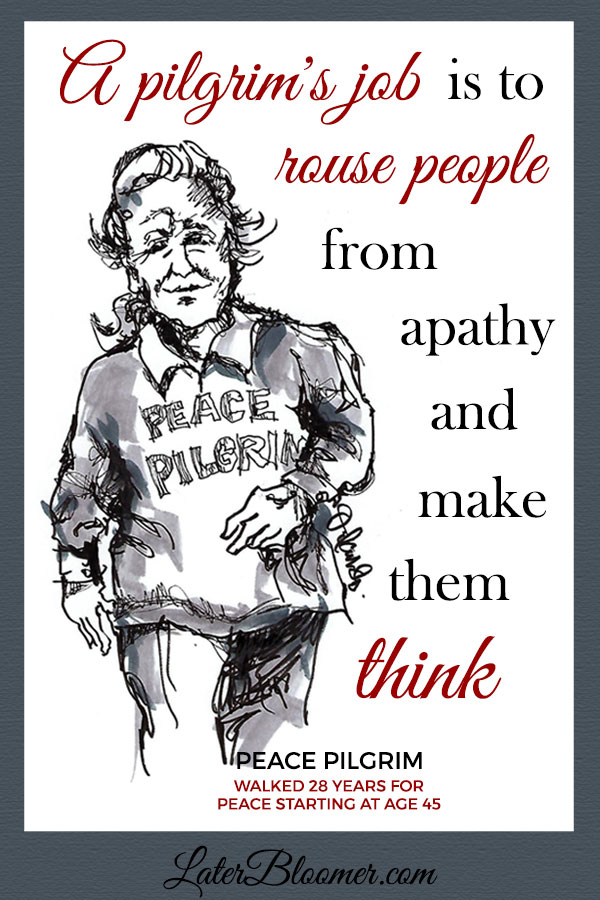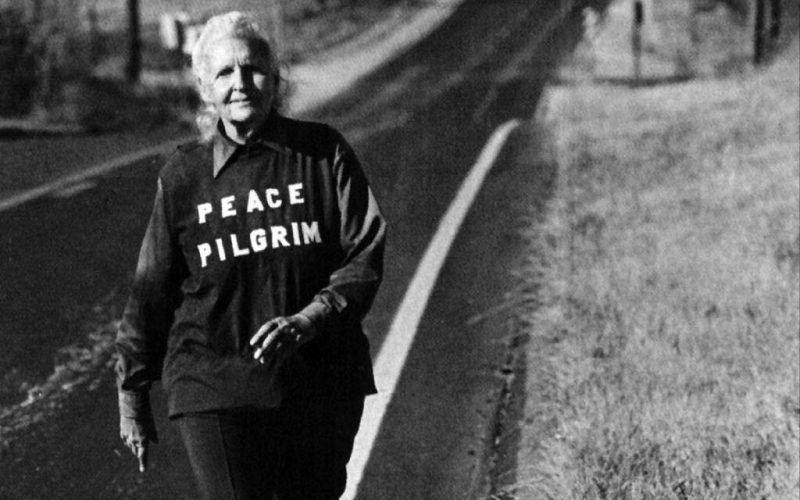There was nothing remarkable about Mildred Lisette Norman (1908-1981) at first.
She grew up on a poultry farm in Egg Harbor City, New Jersey. Her family wasn’t religious. At age 16, she set foot in a church for the first time to attend a wedding.
She was captain of her high school debate team and class valedictorian.
You’d never guess that, at age 45, she’d give away all her possessions, don a tunic emblazoned Peace Pilgrim, and walk the U.S. for 28 years preaching nonviolence.
The Flapper
After high school, she worked as a secretary. Her sister recalled that “she was very much what they called a flapper in those days. She had to have the latest clothing.” Mildred even made special trips to Atlantic City to have her shoes dyed to match her hat and gloves.
At age 25, she eloped with Stanley Ryder, a ne’er-do-well her family had doubts about. He tried and failed to start a trucking firm, then hid it by writing bad checks, banking on his father-in-law’s good name.
Stanley and Mildred had little in common. He wanted a homemaker, she disliked housework. He wanted a quiet wife, she had a mouth. They divorced at the onset of World War II—Stanley wanted to enlist. Mildred was a pacifist.
The impact of war, divorce, and her father’s recent death sent her into the woods one night. She walked for hours until she came upon a gorgeous moonlit clearing. Exhausted yet awestruck, she spoke to the universe,
“If you can use me for anything, please use me…I withhold nothing.” And then of course, I felt I had found what I was seeking. I experienced a complete willingness, without reservations whatsoever, to give my life to something beyond myself.”
Mildred began a fifteen-year preparation period, still unsure of her mission. As she later remarked, “There’s a great deal of difference between being willing to give your life and actually giving your life.”
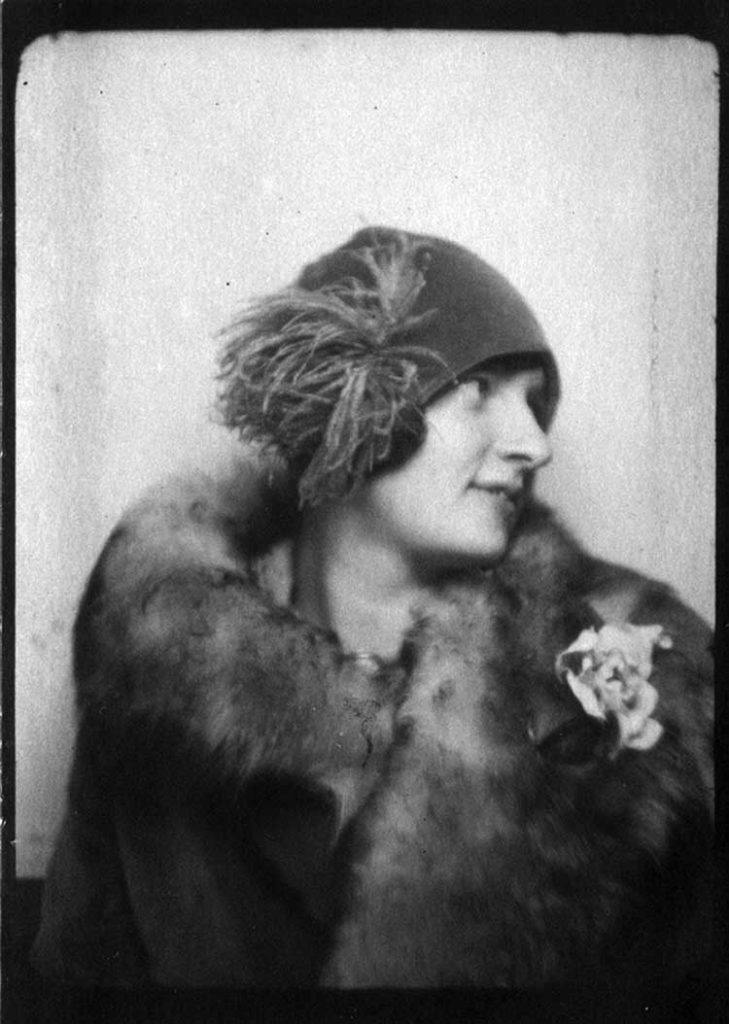
The Seeker
Throughout her thirties, Mildred searched for her mission. She worked with senior citizens and the emotionally-disturbed. She volunteered with peace organizations, including the Quaker American Friends Service Committee and the Women’s International League for Peace and Freedom.
She became a vegetarian and gave up caffeine. She stopped eating white flour and white sugar (decades before their dangers made the news). She relinquished “self-will,” which she defined as her lower impulses. “If you are motivated to do or say a mean thing, you can always think of a good thing.”
In 1952, Mildred walked the Appalachian Trail in one season, becoming the first woman to do so. “There were hills and valleys, lots of hills and valley, in that spiritual growing up period,” she recalled. She spoke both physically and metaphorically.
One day, she rested on a high hill overlooking the New England countryside. Around her, the Korean War raged and McCarthyism ruined lives. She felt motivated to make a pilgrimage for peace.
But where? In her mind’s eye, she saw a map of the United States colored with a zigzag route from Los Angeles to New York. Suddenly, she knew.
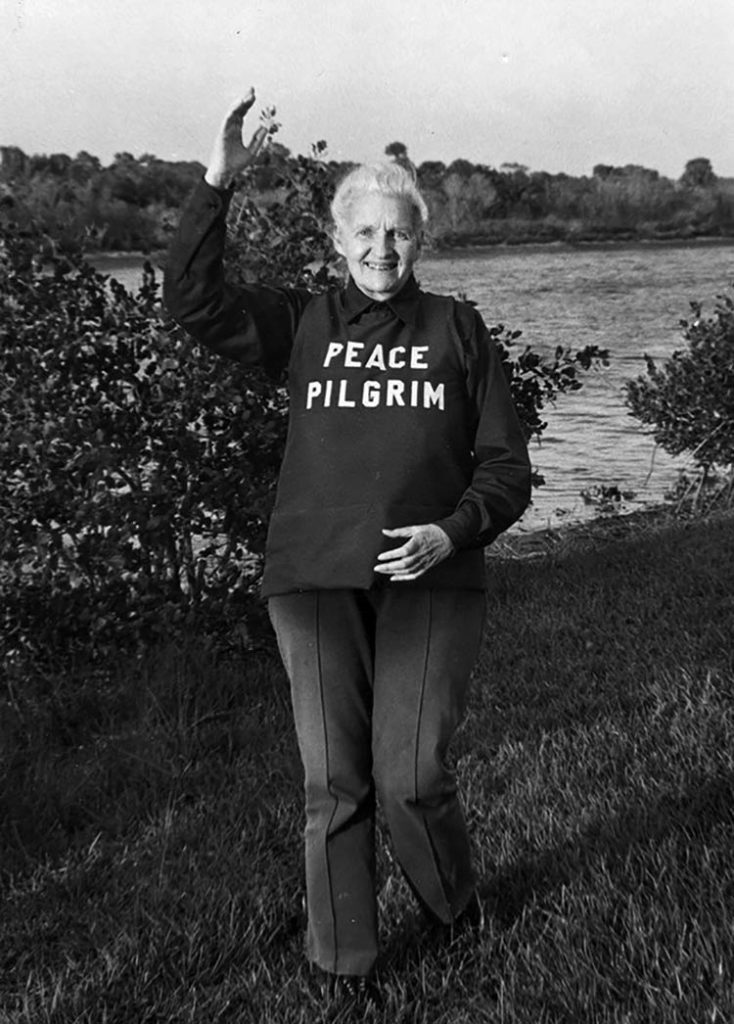
The Pilgrim
PRESS RELEASE
Los Angeles, California, January 1, 1953Out of the early morning mist there appeared a woman. The only remarkable thing about her was the sign she wore. The back read “Walking Coast to Coast for Peace,” the front “Peace Pilgrim.”
“Just call me Peace Pilgrim,” she said. “In undertaking this pilgrimage I do not think of myself as an individual, but rather as an embodiment of the heart of the world, which is pleading for peace.”
Her steps were light and swift, and she seemed to glide along effortlessly as she mingled with the New Year’s Day festivities. “I’m starting my pilgrimage today,” she announced. “I shall walk across this beautiful land of ours to New York City, and then to Washington D.C.”
“The world situation is grave,” she continued. “Humanity, with fearful, faltering steps, walks a knife edge between abysmal chaos and a new renaissance, while strong forces push toward chaos. Yet there is hope…
Mildred walked ahead of Pasadena’s famous Rose Parade, talking to people and handing out peace petitions.
They included one requesting immediate peace in Korea, another pleading for a national Peace Department, and a third, directed to the U.N., seeking freedom for the world from the burden of armaments.
It would be easy to doubt her sincerity. She wrote her own press release, after all. It reads like the beginning of a beautiful fairy tale—Out of the early morning mist there appeared a woman.
But when the Rose Parade ended, Mildred Lisette Norman Ryder, age 45, kept walking her talk—for 28 years.
She vowed “to remain a wanderer until mankind has learned the way of peace.” She represented no group or religion, petitioned no sponsors, carried no money.
She stored her worldly goods in the pockets of her Peace Pilgrim tunic—a comb, a folding toothbrush, a ballpoint pen, copies of her messages. She relied upon the kindness of strangers.
As she later explained, her tunic brought people to her. She seldom had to ask for a meal or place to sleep.
It [the tunic] makes my contacts for me in the kindest way, in the most effective way. You’re in a much better position to talk to people when they approach you, then when you approach them. And I notice that those who come are worthwhile people. They either are genuinely interested in peace or they have a good lively curiosity.
The FBI investigated Mildred for un-American activities and harassed her sister for details of her life, so she legally changed her name to Peace Pilgrim. The Bureau kept files on her until 1967.
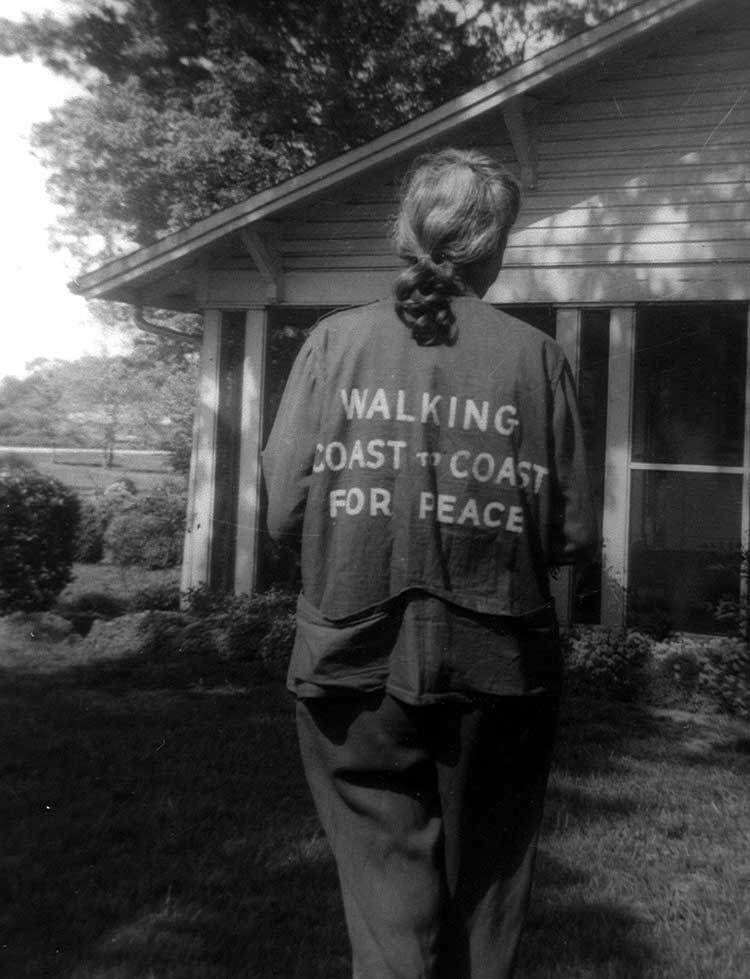
The Sage
After she finished her first pilgrimage, Peace Pilgrim became a popular speaker at churches and schools. Her message spoke to everyone.
One woman said she taught Bahai beliefs. A college student felt sure she was a Christian Scientist. Two young men thought she espoused Eastern philosophies. Others heard Jewish, Muslim, and Unitarian tenets.
Someone once told her, “What you say is what the saints have said down through the ages.” Peace Pilgrim answered, “I know there is nothing new in my message, just the practice of it.”
She continued to walk daily, crossing the country seven times. In 1964, she stopped counting miles after reaching 25,000. She wore out 29 pairs of sneakers, averaging 1500 miles per pair. That equals about 43,500 miles.
On July 7, 1981, Peace Pilgrim was invited to speak at a Senior Citizens Luncheon near Knox, Indiana. A member offered her a ride to the venue.
At 11:30 am, an oncoming car driven by an 18-year-old girl lost control, crossed the median, and hit them head-on. Peace Pilgrim died in the crash, just a week before her 73rd birthday.
It’s probably not the ending you expected, but perhaps Peace Pilgrim did.
She always called death “a glorious transition to freer living.” Right before she died, she told a friend “When my work on this planet Earth is done, I want to move out very quickly.”
The Legacy
But what does her message mean for those of us who can’t abandon our commitments and pursue a full-time spiritual calling at midlife? Peace Pilgrim counsels:
- make peace with some friend or relation.
- join some peace groups so they have some guidance in working for peace.
- get rid of some worry habit or anger habit or fear habit that is keeping their own life from coming into harmony.
The more peace you have in your own life the more you can reflect into your surroundings and ultimately into your world. And every time you succeed in bringing harmony into any inharmonious situation right where you are you make a contribution to the total peace picture…
One of the ways of working for world peace is to work for more inner peace—for world peace will never be stable until enough of us find enough inner peace to stabilize it.
There was nothing remarkable about Mildred Lisette Norman at first. She became extraordinary when she embraced the courage of her convictions in her forties.
It’s never too late to make a difference.
Curious to Know More?
Here’s Peace Pilgrim’s last radio interview, recorded the day before she died (9:41 minutes).
The Friends of Peace Pilgrim would like to gift you a 216-page biography titled Peace Pilgrim: Her Life and Work in Her Own Words. You can download it at PeacePilgrim.org.
(All images of Peace Pilgrim are from PeacePilgrim.org.)
